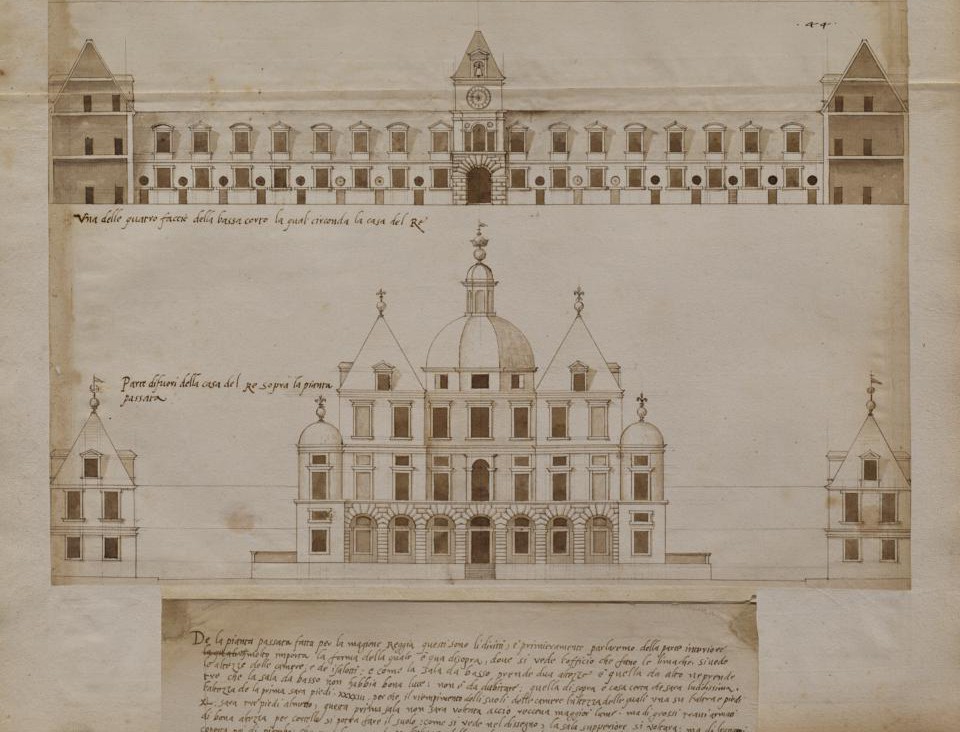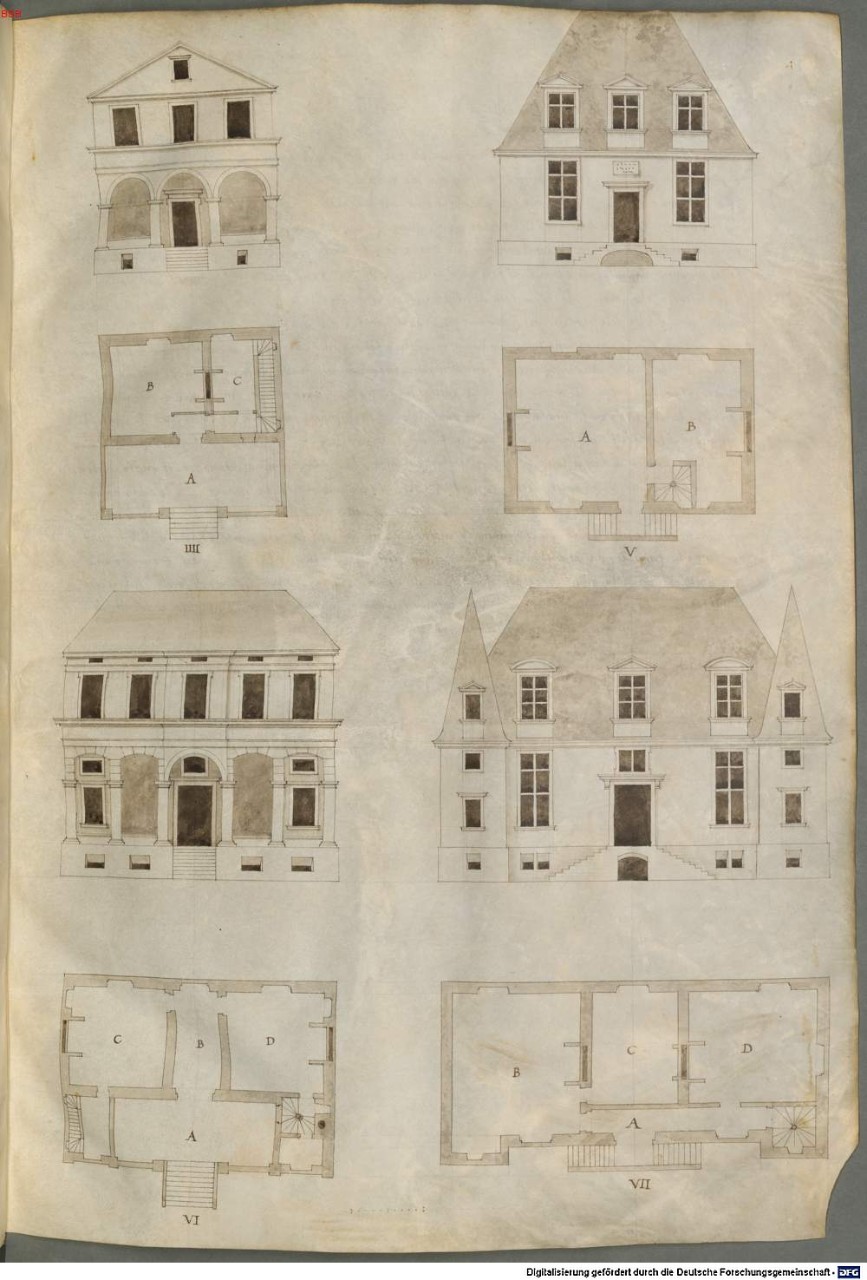Demonet Essay
CHLOÉ DEMONET, Heritage Engineer, French Ministry of Culture, From 16th to 21st century, Transcribing Serlio's Domestic architecture
 Fig. 1. Royal residence in the countryside. Sebastiano Serlio, Sesto libro d'architettura [Avery MS], Plate 44. Avery Classics, Avery Architectural & Fine Arts Library, Columbia University.
Fig. 1. Royal residence in the countryside. Sebastiano Serlio, Sesto libro d'architettura [Avery MS], Plate 44. Avery Classics, Avery Architectural & Fine Arts Library, Columbia University.
As early as the 1530s, Sebastiano Serlio (1475?-1554?), artist and architect from Bologna, began a large-scale editorial project that was originally intended to comprise seven architectural books, devoted to various aspects of the discipline and forming a complete treatise: geometry and perspective, ancient examples, architectural orders, technical problems, as well as to different types of buildings: "temples" and domestic architecture. The publication was progressively carried out in a random order (first Book IV, then Book III, etc.), between Italy and France, Serlio residing there from 1541 (called to Fontainebleau by François Ier, he received the title of Architect of the King). These works were very quickly re-edited and translated, first in French (Books I, II and V are besides bilingual editions); followed by Dutch, German, English and Spanish editions.1
Despite this success, the architect did not succeed in publishing the whole of his treatise. Book VII, which dealt with several topics, was published after his death (in an Italian-Latin bilingual edition), on the initiative of Jacopo Strada who bought the manuscript about 1552. Book VI was never published. Two manuscript versions survive today, as well as a series of engravings. These proofs are preserved at the National Library of Vienna (72.P.20) and could come from a third missing manuscript, a preparatory version of this never fully-realized edition.2 The book in Münich (Bayerische Staatsbibliothek, Cod. Icon. 189) appears as a presentation volume, carefully laid out on parchment and bound. The New York manuscript is earlier and was made on paper (Columbia University, Avery Architectural and Fine Arts Library, AA520 Se619 F). The sheets were in the possession of Jacques Androuet du Cerceau, and remained in France at least until the beginning of the eighteenth century. The manuscript would then have different owners in England, where it was purchased by W.B. Dinsmoor, curator in Avery Library, in 1920. Now removed from its early 20th century binding, the manuscript is almost entirely preserved, even if the original order of the sheets has been disturbed (quite possibly restored by Dinsmoor).
Book VI is dedicated to domestic architecture and organized according to the social position of each one, from the "poor peasant" to the king, through merchants and other princes, and divided into two main parts: countryside residences and city residences (fig. 1-2). The architect also proposes almost systematically a version in the French style ("al costume di franza") of each of these projects, thus adapting to variations in taste and adding to the debate on adoption or resistance of Italian forms.
Digital Serlio
 Fig. 2. House examples for “skilled worker" or "city dweller or merchant." Sebastiano Serlio, Sesto libro d'architettura [Münich MS], f.4r. Münchener DigitalisierungsZentrum Digitale Bibliothek. Licensed under CC BY-NC-SA 4.0.
Fig. 2. House examples for “skilled worker" or "city dweller or merchant." Sebastiano Serlio, Sesto libro d'architettura [Münich MS], f.4r. Münchener DigitalisierungsZentrum Digitale Bibliothek. Licensed under CC BY-NC-SA 4.0.
The project concerns firstly the digitization of the manuscript of Book VI and its provision for different scholars in a virtual workspace hosted by the Getty Research Institute. The Getty Scholars' Workspace aims to foster scientific collaboration around digitized sources that are transcribed, translated and commented on in this online platform. It offers the possibility of comparing different sheets on a digital light table, annotating documents and producing comments in a forum common to the various researchers involved in the project, who can also enrich the bibliography and of course put forward papers. An ambitious project has already been completed thanks to this work tool, and led to the creation of an online edition of a manuscript kept by the Getty Research Institute (Pietro Mellini's Inventory in Verse, 1681: A Digital Facsimile with Translation and Commentary).3
In addition to collaboration and easy access to sources, this workspace allows for regular updates and developments. It also serves to facilitate the development of knowledge, and to highlight the library’s collections. In the case of Digital Serlio, the digitization of the manuscript was combined with that of all the editions of the Serlio books owned by the Avery Library - 31 volumes (from 1537 to 1663). The digitization process revealed that some of these books had been cataloged on the first page of the title while they sometimes contained several books belonging to the treaty; an update was made in the online catalog of the Columbia University Libraries as well as in the digital library Internet Archive where these books are now fully searchable.
Initiated by Avery Library, in collaboration with Francesco Benelli, architect and professor of architecture history (University of Bologna), the project brings together a multidisciplinary team within the library: Carole Ann Fabian, director of the Avery Library, Teresa Harris, Curator of Classics, and Margaret Smithglass, Registrar and Digital Content Librarian. The institution worked closely with the team at the Getty Research Institute for the technical development of the workspace. In addition to the University of Bologna, other partners include the Samuel Freeman Charitable Trust Foundation, the Graduate School of Architecture Planning and Preservation, the Italian Academy for Advanced Studies in America, and the National School of Charters for the transcription of the manuscript. This transcription is complete, and an English translation is in progress. The common workspace will soon be accessible to the scholars involved in the project, all specialists on the architectural treatise: Francesco Benelli (Università di Bologna, It.), Maria Beltramini (Roma 2, It.), Sabine Frommel (Ecole pratique des Hautes Etudes, Fr.), Sara Galletti (Duke University, US), Mauro Mussolin (Scuola Normale Superiore di Pisa and New York University, It.-US), Mark Rakatansky (Columbia GSAPP, US) and Francesca Mattei (Politecnico di Milano, It.).
The project will be presented in various international events – potentially at the Fontainebleau Festival de l’histoire de l’art, whose 2017 edition has the United States as guest country, and at the 46th annual conference of the Art Libraries Society of North America, to be held at the end of February 2018 in New York. Digital Serlio will then be completed and migrated to the online edition. It will be hosted on the common website of the Columbia University Libraries' online collections.
Transcribing Serlio
This transcription, which will soon be available on the workspace, will be the first published literal transcription of the Avery Library manuscript. The Münich manuscript, perhaps because of its more complete form, has received more attention from researchers, and a complete transcription was proposed by F. P. Fiore in 1994.4 In addition, an English translation was published in 20015; on this occasion a small part of the Avery manuscript had also been translated, with the aim of highlighting the variants between the two texts. A first reproduction with commentary was published in 1978.6
Shortly after the purchase of the manuscript in 1920, W. B. Dinsmoor, the third librarian of Avery Library (1920-1926) began to prepare an edition of it. He gathered abundant material on the history of the manuscript, which analysis was published in two articles published later in 1942, in The Art Bulletin.7 But his ambitious project could not be successfully completed, although he had already prepared a transcription and translation, now preserved in the library archives (361 and 318 sheets of paper, with collages of Paper, partially typewritten and handwritten in black and red ink).8 Dinsmoor’s transcription mixes the text of the Avery manuscript with that of Munich, for the few missing parts, but also for certain variants retained as significant by the researcher. In this transcription, the Italian of Serlio is partially modernized: the specific words are maintained but more modern usages are also employed.
As part of the Digital Serlio project, the transcription strictly respects the architect's text, both in its language and in its layout (by indicating passages and line breaks) and pays attention to the erasures and corrections which often provide valuable insights into the process of composing comments. The book is in fact made of a series of plates, briefly annotated, with a descriptive and explanatory commentary. The text will be translated into English (with the possibility of proposing other translations). The online work platform will allow for comparisons between the original text, the transcription and the translation.
Digital Serlio is an opportunity to experiment in an online workspace around a facsimile whose quality of digitization allows different approaches, including a material approach, of the work. The proposed tools also make it possible to meet the expectations of the scholars who are involved in the project, allowing them to collaborate as in a real workshop. The principle is that of a common editorial project, but entirely realized on the web, with the new possibilities offered by digitization and an online interactive space. Enjoy Digital Serlio in Fall 2018.
Notes
1 M. VENE, Bibliographia serliana, Catalogue des éditions imprimées des livres du traité d’architecture de Sebastiano Serlio (1537-1681), Picard, Paris, 2007
2 M.N. ROSENFELD, Sebastiano Serlio on domestic architecture, New York, Architectural History Foundation, Cambridge, Massachusetts, 1978
3 http://www.getty.edu/research/mellini/ (consulted on Novembre 28th 2016)
4 F. P. FIORE & T. CARUNCHIO (éd.), S. Serlio, Architettura Civile, Libri Sesto, Settimo e Ottavono nei manoscritti di Monaco e Vienna, Milan, Il Polifilo, 1994
5 Sebastiano Serlio on Architecture, Volume Two, Books VI-VII of ‘Tutte lopere d’architettura et prospetiva’ with ‘Castrametation of the Romans’ and ‘The Extraordinary Book of Doors’ by Sebastiano Serlio, translated from the Italian with an introduction and commentary by V. Hart and P. Hicks, New Haven/Londres, Yale University Press, 2001
6 M.N. ROSENFELD, Op. Cit.
7 W. B. DINSMOOR, “The Literary Remains of Sebastiano Serlio” in The Art Bulletin, Vol. 24, No. 1 (Mar., 1942), pp. 55-91 et No. 2 (Jun., 1942), pp. 115-154
8 Avery Drawings and Archives: D&A Dinsmoor ReCAP
Additional Information about Book VI
The Avery Architectural and Fine Arts Library actively develops online presentations of its collections through various digital projects, in collaboration with the Columbia University Libraries' Digital Programs Division. In an effort to promote an important manuscript of Sebastiano Serlio, Avery is currently experimenting with the Getty Scholars’ virtual workspace, which will create access to a digitized version of the manuscript and facilitate research and collaboration among Serlio scholars around the globe.
Serlio’s editorial project and the Book VI manuscript